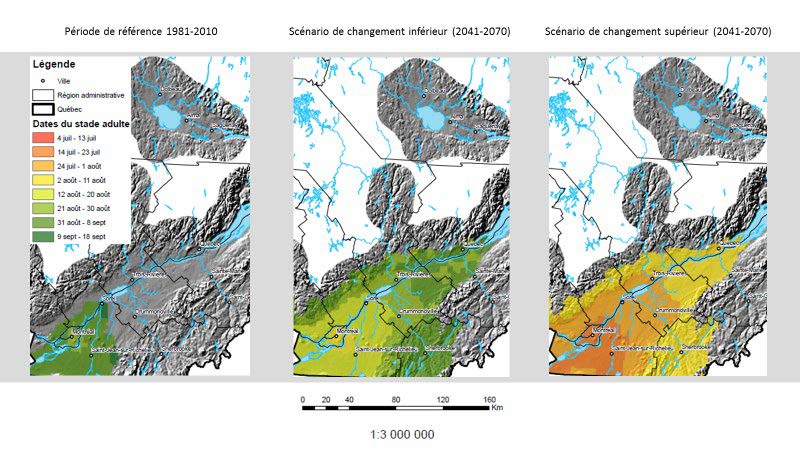Adaptation of Phytosanitary Measures for Pests and Diseases of Fruit Crops in Regard to Climate Change Impacts
The knowledge resulting from this project will enable the development or revision of planning and action tools for decision makers in order to assist the crop protection sector to adapt to climate change.
Project details
Principal(s) investigator(s)

Context
The impacts of climate change on agricultural production in Québec include a possible increase in pressure from certain crop pests that are either already present in Québec or are alien invasive species (AIS).
Although changes have been observed in the past, little is known about the way in which insect pests and diseases of fruit crops will evolve in response to climate change in Québec. It is essential to address this knowledge gap in order to help agriculture sector stakeholders prepare to respond to the expected changes.
Objective(s)
-
Document the impact of climate change on insect pests and diseases of four fruit crops in Québec (apples, cranberries, strawberries and raspberries) and identify appropriate adaptation measures.
Methodology
-
Document the characteristics of insect pests and diseases of the crops in question, identify those that present a risk under the expected changes in Québec’s climate (literature review) and select six case studies (expert consultations);
-
Assess the impacts of climate change on the case studies over the 2050 time horizon, using bioclimatic models applied to spatial analogs in North American or European regions whose current climate resembles the projected climate of Québec;
-
Identify appropriate adaptation measures for Québec.
Results
A list of 54 pests and diseases endemic to Québec that are likely to evolve in response to climate change and a list of 28 exotic species that pose a threat to Québec fruit crops were drawn up. Among the latter, 15 information sheets were produced for those with a high risk of introduction into Québec. These sheets will be disseminated to the fruit sectors through Agriréseau and the Réseaux d’Avertissements Phytosanitaires.
Each fruit crop in the study (cranberry, apple, strawberry, raspberry) will be affected by climate change. For the plant models and the insect and mite models, climate change appears to have a direct impact with, most often, a two-week advance in plant and pest phenology under the highest phenological change scenarios.
However, synchrony between the host and its pest/disease will be maintained. With increasing temperatures, insect development times will be shorter and phytosanitary intervention response times will be reduced.
For multivoltine species, which produce more than one generation per year (such as the codling moth, the cyclamen mite and the blackheaded fireworm), the number of generations per growing season will increase.
As a result, pressure from these insects will be greater and the number of phytosanitary interventions may also increase if alternative methods are not used. Furthermore, by 2050, the range of the insects under study could spread. For example, the brown marmorated stink bug, which is now established in the Montréal region, could expand its range in Québec, and could be seen as far as the National Capital region (Figure 1).
Climate change will also have an impact on disease. For example, the incidence of bitter rot infection (Colletotrichun acutatum) is likely to increase in the future.

Figure 1. Mean adult apparition date for the first generation of brown marmorated stink bug by reference period and low and high change scenarios (2041-2070). Figure 1 shows that first generation of adults will appear 19 to 48 days earlier depending on the scenario. Given the expected delay in first frost dates due to climate change, the brown marmorated stink bug will be able to overwinter from Montérégie to Québec City in the future.
Consultation workshops with stakeholders from the different fruit sectors led to recommendations for adaptation measures to be put in place. Several recommendations focus on prevention and the application of alternative methods to avoid the emergence of resistance from the increased use of pesticides used to control more problematic pests and diseases.
In addition, information sheets for each fruit sector were produced to help agricultural advisors and farmers to better deal with the effects of climate change.
Benefits for adaptation
Benefits for adaptation
The knowledge resulting from this project will enable the development or revision of planning and action tools for decision makers in order to assist the crop protection sector to adapt to climate change;
Technical support clubs will also be able to use the results to plan a progressive adaptation of their services for farmers in response to identified threats;
The project could also have an impact on the services offered by the Réseau d’avertissements phytosanitaires (RAP) and the and the MAPAQ’s plant protection diagnostic laboratory (LEDP).
Scientific publications
Funding

Other participants
-
Agriculture and Agri-food Canada (AAC)
-
Club environnemental et technique Atocas Québec (CETAQ)
-
Ministère de l’Agriculture, des Pêcheries et de l’Alimentation (MAPAQ)